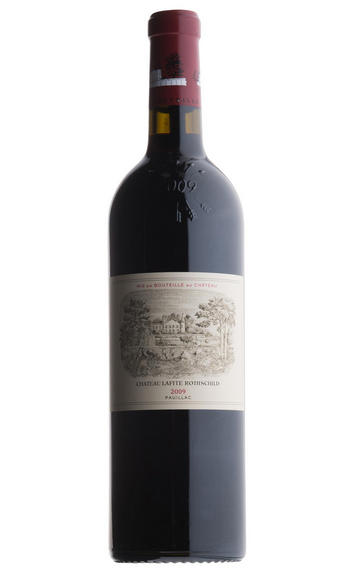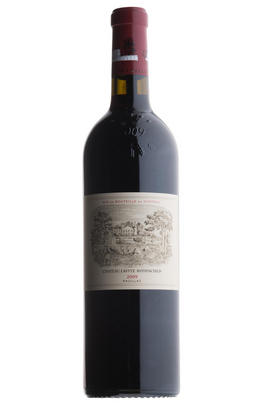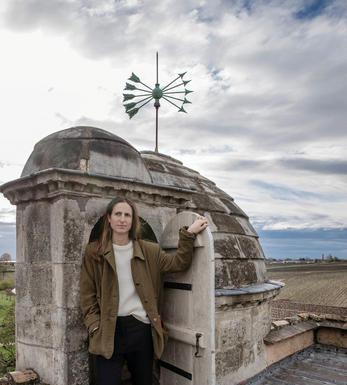
2009 Château Lafite Rothschild, Pauillac, Bordeaux

Critics reviews
The 2009 Lafite-Rothschild is quite high-toned and expressive on the nose, perhaps the most ostentatious of the top flight 2009s with upfront black cherry and boysenberry fruit, lavish new oak and touches of violet.
The palate is sleek and satin-like in feel with copious dark cherry and boysenberry fruit, fig and dates, almost honeyed in texture towards the precocious finish that has an opulent bent, almost hedonistic, unusual for this First Growth. But it is kinda irresistible. Tasted blind at Farr Vintners’ 2009 Bordeaux tasting.
Drink 2020 - 2050
Neal Martin, Vinous.com (February 2019)
It displays, as Lafite always does, more of a laid-back elegance than Latour, and the difference between the two once again highlights the huge differences in terroir between north and south Pauillac, with the deep gravels here giving finesse, composure, and almost nonchalance.
It tames with a whisper, bringing you to submission by gently, purposefully and slowly layering one thing on top of another. It has gorgeously pure and precise fruit on the nose, while the palate displays many flavours, from charcoal to cassis to crushed stone, yet no one dominates.
There are a ton of tannins, but they are individually fine, and it's only in retrospect that you realise how many of them there are. The tone of Lafite is speaking over the vintage, and it's going to run and run.
Drink 2024 - 2046
Jane Anson, JaneAnson.com (February 2019)
The deep garnet-coloured 2009 Lafite Rothschild bursts from the glass with red and black currant preserves, warm plums, mulberries and kirsch scents, plus suggestions of sweaty leather, cigar box and menthol. It is medium-bodied, elegant and firmly structured, and has wonderful freshness and a long earthy/meaty finish.
Drink 2019 - 2049
Lisa Perrotti-Brown, Wine Advocate (March 2019)
This wine is stunningly impressive but almost the opposite of the 2010 vintage. The year offered a warm, wet spring followed by a hot, dry summer and cool nights in September, giving a riper, more generous impression. A bit of smoke and spice on the initial attack with a ripe, plummy fruit character that is more black than red and a supple, dense richness on the palate that lingers sumptuously on the finish.
This vintage will drink sooner than the 2010, yet it should easily last as long. The finished wine blends 82.5% Cabernet Sauvignon, 17% Merlot, and a half-per-cent Petit Verdot. Picking began in mid-September for the Merlot and early October for the Cabernet, with 45% of the fruit going into the grand vin.
Drink 2032 - 2082
Charles Curtis MW, Decanter.com (March 2022)
About this WINE

Château Lafite Rothschild
The iconic Château Lafite Rothschild was classified as a first growth in 1855 and has been in the Rothschild family since 1868. Today, Lafite is headed up by Saskia de Rothschild, daughter of long-time steward Baron Eric de Rothschild.
Château Lafite Rothschild is an iconic first-growth property in the Pauillac appellation of Bordeaux, France. It achieved its top-tier rank in 1855 and has been in the Rothschild family since 1868. Today, Lafite is headed up by Saskia de Rothschild, daughter of long-time steward Baron Eric de Rothschild.
The property is located at the northern tip of Pauillac, separated by St Estèphe by marshland and the Jalle de Breuil stream. Two areas of the vineyard are particularly notable: the gravel plateau, which is the heart of the grand vin; and the Plateau de Carruades, from which Lafite’s second wine takes its name. The vineyard is planted mostly to Cabernet Sauvignon (70%), along with Merlot (25%), Cabernet Franc (3%) and Petit Verdot (2%).
A new cellar was completed here in time for the 2011 harvest, with a combination of stainless steel and concrete tanks, of varying sizes. The barrels come from Lafite’s own cooperage, located not far from the property.
In addition to its 110 hectares of vines, the estate has 300 hectares of woods and marshes. The team consider this to be an integral part of the ecosystem.

Pauillac
Pauillac is the aristocrat of the Médoc boasting boasting 75 percent of the region’s First Growths and with Grand Cru Classés representing 84 percent of Pauillac's production.
For a small town, surrounded by so many familiar and regal names, Pauillac imparts a slightly seedy impression. There are no grand hotels or restaurants – with the honourable exception of the establishments owned by Jean-Michel Cazes – rather a small port and yacht harbour, and a dominant petrochemical plant.
Yet outside the town, , there is arguably the greatest concentration of fabulous vineyards throughout all Bordeaux, including three of the five First Growths. Bordering St Estèphe to the north and St Julien to the south, Pauillac has fine, deep gravel soils with important iron and marl deposits, and a subtle, softly-rolling landscape, cut by a series of small streams running into the Gironde. The vineyards are located on two gravel-rich plateaux, one to the northwest of the town of Pauillac and the other to the south, with the vines reaching a greater depth than anywhere else in the Médoc.
Pauillac's first growths each have their own unique characteristics; Lafite Rothschild, tucked in the northern part of Pauillac on the St Estèphe border, produces Pauillac's most aromatically complex and subtly-flavoured wine. Mouton Rothschild's vineyards lie on a well-drained gravel ridge and - with its high percentage of Cabernet Sauvignon - can produce (in its best years) Pauillac's most decadently rich, fleshy and exotic wine.
Latour, arguably Bordeaux's most consistent First Growth, is located in southern Pauillac next to St Julien. Its soil is gravel-rich with superb drainage, and Latour's vines penetrate as far as five metres into the soil. It produces perhaps the most long-lived wines of the Médoc.
Recommended Châteaux
Ch. Lafite-Rothschild, Ch. Latour, Ch. Mouton-Rothschild, Ch. Pichon-Longueville Baron, Ch. Pichon Longueville Comtesse de Lalande, Ch. Lynch-Bages, Ch. Grand-Puy-Lacoste, Ch, Pontet-Canet, Les Forts de Latour, Ch. Haut-Batailley, Ch. Batailley, Ch. Haut-Bages Libéral.

Cabernet Sauvignon Blend
Cabernet Sauvignon lends itself particularly well in blends with Merlot. This is actually the archetypal Bordeaux blend, though in different proportions in the sub-regions and sometimes topped up with Cabernet Franc, Malbec, and Petit Verdot.
In the Médoc and Graves the percentage of Cabernet Sauvignon in the blend can range from 95% (Mouton-Rothschild) to as low as 40%. It is particularly suited to the dry, warm, free- draining, gravel-rich soils and is responsible for the redolent cassis characteristics as well as the depth of colour, tannic structure and pronounced acidity of Médoc wines. However 100% Cabernet Sauvignon wines can be slightly hollow-tasting in the middle palate and Merlot with its generous, fleshy fruit flavours acts as a perfect foil by filling in this cavity.
In St-Emilion and Pomerol, the blends are Merlot dominated as Cabernet Sauvignon can struggle to ripen there - when it is included, it adds structure and body to the wine. Sassicaia is the most famous Bordeaux blend in Italy and has spawned many imitations, whereby the blend is now firmly established in the New World and particularly in California and Australia.


Buying options
Add to wishlist
Description
The 2009 Lafite-Rothschild is quite high-toned and expressive on the nose, perhaps the most ostentatious of the top flight 2009s with upfront black cherry and boysenberry fruit, lavish new oak and touches of violet.
The palate is sleek and satin-like in feel with copious dark cherry and boysenberry fruit, fig and dates, almost honeyed in texture towards the precocious finish that has an opulent bent, almost hedonistic, unusual for this First Growth. But it is kinda irresistible. Tasted blind at Farr Vintners’ 2009 Bordeaux tasting.
Drink 2020 - 2050
Neal Martin, Vinous.com (February 2019)
wine at a glance
Delivery and quality guarantee